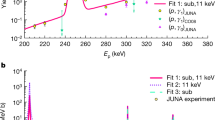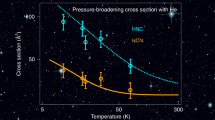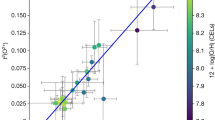Abstract
IN the preceding communication, Palmer et al. have reported the observation of an emission line close to the expected position of the recombination line 109α of C I in the radiofrequency spectra of the ionized hydrogen regions NGC 2024 and IC 1795. The total intensity of the newly observed line is about 3 per cent that of the neighbouring 109α line of H I. Let us assume that the two lines originate from the same volume of space. If the upper levels of C I and H I were populated in thermodynamic equilibrium, the relative intensities of the two lines would be roughly in the ratio of the numbers of hydrogen and carbon ions in the emitting volume. This ratio would be equivalent to that of the cosmic abundances of hydrogen and carbon if both atoms were entirely in the singly ionized condition. In the Sun, the abundance of carbon is 5 × 10−4 of that of hydrogen1, and there is no reason to suppose that the ratio is greatly different in H II regions. Thus, if the line found by Palmer et al. is indeed the 109α line of C I, its observed intensity relative to that of the same transition in hydrogen is at least sixty times greater than would be expected from the two assumptions of thermodynamic equilibrium and normal cosmic abundances. In this communication we point out that the apparently anomalous overpopulation of the n = 110 level of C I can be explained as a result of departures from thermodynamic equilibrium, which result in the preferential population of levels of high total quantum number by dielectronic recombination.
This is a preview of subscription content, access via your institution
Access options
Subscribe to this journal
Receive 51 print issues and online access
$199.00 per year
only $3.90 per issue
Buy this article
- Purchase on Springer Link
- Instant access to full article PDF
Prices may be subject to local taxes which are calculated during checkout
Similar content being viewed by others
References
Goldberg, L., Müller, E. A., and Aller, L. H., Astrophys. J. Suppl., 5, 1 (1960).
Seaton, M. J., Mon. Not. Roy. Astro. Soc., 127, 177 (1964).
Burgess, A., Smithsonian Astrophysical Observatory Spec. Rep. No. 174, 47 (1965).
Seaton, M. J., Mon. Not. Roy. Astro. Soc., 119, 81 (1959).
Goldberg, L., Astrophys. J., 144, 1225 (1966).
Seaton, M. J., Mon. Not. Roy. Astro. Soc., 111, 368 (1951).
Burgess, A., Astrophys. J., 141, 1588 (1965).
Author information
Authors and Affiliations
Rights and permissions
About this article
Cite this article
GOLDBERG, L., DUPREE, A. Population of Atomic Levels by Dielectronic Recombination. Nature 215, 41–43 (1967). https://doi.org/10.1038/215041a0
Received:
Issue Date:
DOI: https://doi.org/10.1038/215041a0
This article is cited by
-
Anomalous Recombination Line 166α
Nature (1970)
Comments
By submitting a comment you agree to abide by our Terms and Community Guidelines. If you find something abusive or that does not comply with our terms or guidelines please flag it as inappropriate.



